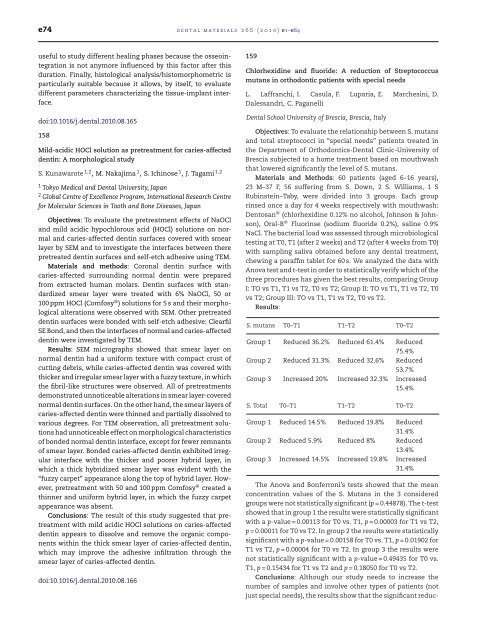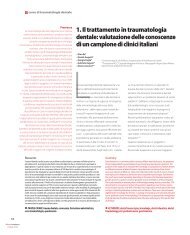Abstracts of the Academy of Dental Materials Annual ... - IsiRed
Abstracts of the Academy of Dental Materials Annual ... - IsiRed
Abstracts of the Academy of Dental Materials Annual ... - IsiRed
You also want an ePaper? Increase the reach of your titles
YUMPU automatically turns print PDFs into web optimized ePapers that Google loves.
e74 dental materials 26S (2010) e1–e84<br />
useful to study different healing phases because <strong>the</strong> osseointegration<br />
is not anymore influenced by this factor after this<br />
duration. Finally, histological analysis/histomorphometric is<br />
particularly suitable because it allows, by itself, to evaluate<br />
different parameters characterizing <strong>the</strong> tissue-implant interface.<br />
doi:10.1016/j.dental.2010.08.165<br />
158<br />
Mild-acidic HOCl solution as pretreatment for caries-affected<br />
dentin: A morphological study<br />
S. Kunawarote 1,2 , M. Nakajima 1 , S. Ichinose 1 , J. Tagami 1,2<br />
1 Tokyo Medical and <strong>Dental</strong> University, Japan<br />
2 Global Centre <strong>of</strong> Excellence Program, International Research Centre<br />
for Molecular Sciences in Tooth and Bone Diseases, Japan<br />
Objectives: To evaluate <strong>the</strong> pretreatment effects <strong>of</strong> NaOCl<br />
and mild acidic hypochlorous acid (HOCl) solutions on normal<br />
and caries-affected dentin surfaces covered with smear<br />
layer by SEM and to investigate <strong>the</strong> interfaces between <strong>the</strong>re<br />
pretreated dentin surfaces and self-etch adhesive using TEM.<br />
<strong>Materials</strong> and methods: Coronal dentin surface with<br />
caries-affected surrounding normal dentin were prepared<br />
from extracted human molars. Dentin surfaces with standardized<br />
smear layer were treated with 6% NaOCl, 50 or<br />
100 ppm HOCl (Comfosy ® ) solutions for 5 s and <strong>the</strong>ir morphological<br />
alterations were observed with SEM. O<strong>the</strong>r pretreated<br />
dentin surfaces were bonded with self-etch adhesive: Clearfil<br />
SE Bond, and <strong>the</strong>n <strong>the</strong> interfaces <strong>of</strong> normal and caries-affected<br />
dentin were investigated by TEM.<br />
Results: SEM micrographs showed that smear layer on<br />
normal dentin had a uniform texture with compact crust <strong>of</strong><br />
cutting debris, while caries-affected dentin was covered with<br />
thicker and irregular smear layer with a fuzzy texture, in which<br />
<strong>the</strong> fibril-like structures were observed. All <strong>of</strong> pretreatments<br />
demonstrated unnoticeable alterations in smear layer-covered<br />
normal dentin surfaces. On <strong>the</strong> o<strong>the</strong>r hand, <strong>the</strong> smear layers <strong>of</strong><br />
caries-affected dentin were thinned and partially dissolved to<br />
various degrees. For TEM observation, all pretreatment solutions<br />
had unnoticeable effect on morphological characteristics<br />
<strong>of</strong> bonded normal dentin interface, except for fewer remnants<br />
<strong>of</strong> smear layer. Bonded caries-affected dentin exhibited irregular<br />
interface with <strong>the</strong> thicker and poorer hybrid layer, in<br />
which a thick hybridized smear layer was evident with <strong>the</strong><br />
“fuzzy carpet” appearance along <strong>the</strong> top <strong>of</strong> hybrid layer. However,<br />
pretreatment with 50 and 100 ppm Comfosy ® created a<br />
thinner and uniform hybrid layer, in which <strong>the</strong> fuzzy carpet<br />
appearance was absent.<br />
Conclusions: The result <strong>of</strong> this study suggested that pretreatment<br />
with mild acidic HOCl solutions on caries-affected<br />
dentin appears to dissolve and remove <strong>the</strong> organic components<br />
within <strong>the</strong> thick smear layer <strong>of</strong> caries-affected dentin,<br />
which may improve <strong>the</strong> adhesive infiltration through <strong>the</strong><br />
smear layer <strong>of</strong> caries-affected dentin.<br />
doi:10.1016/j.dental.2010.08.166<br />
159<br />
Chlorhexidine and fluoride: A reduction <strong>of</strong> Streptococcus<br />
mutans in orthodontic patients with special needs<br />
L. Laffranchi, I. Casula, F. Luparia, E. Marchesini, D.<br />
Dalessandri, C. Paganelli<br />
<strong>Dental</strong> School University <strong>of</strong> Brescia, Brescia, Italy<br />
Objectives: To evaluate <strong>the</strong> relationship between S. mutans<br />
and total streptococci in “special needs” patients treated in<br />
<strong>the</strong> Department <strong>of</strong> Orthodontics-<strong>Dental</strong> Clinic-University <strong>of</strong><br />
Brescia subjected to a home treatment based on mouthwash<br />
that lowered significantly <strong>the</strong> level <strong>of</strong> S. mutans.<br />
<strong>Materials</strong> and Methods: 60 patients (aged 6–16 years),<br />
23 M–37 F, 56 suffering from S. Down, 2 S. Williams, 1 S<br />
Rubinstein–Taby, were divided into 3 groups. Each group<br />
rinsed once a day for 4 weeks respectively with mouthwash:<br />
Dentosan ® (chlorhexidine 0.12% no alcohol, Johnson & Johnson),<br />
Oral-B ® Fluorinse (sodium fluoride 0.2%), saline 0.9%<br />
NaCl. The bacterial load was assessed through microbiological<br />
testing at T0, T1 (after 2 weeks) and T2 (after 4 weeks from T0)<br />
with sampling saliva obtained before any dental treatment,<br />
chewing a paraffin tablet for 60 s. We analyzed <strong>the</strong> data with<br />
Anova test and t-test in order to statistically verify which <strong>of</strong> <strong>the</strong><br />
three procedures has given <strong>the</strong> best results, comparing Group<br />
I: TO vs T1, T1 vs T2, T0 vs T2; Group II: TO vs T1, T1 vs T2, T0<br />
vs T2; Group III: TO vs T1, T1 vs T2, T0 vs T2.<br />
Results:<br />
S. mutans T0–T1 T1–T2 T0–T2<br />
Group 1 Reduced 36.2% Reduced 61.4% Reduced<br />
75.4%<br />
Group 2 Reduced 31.3% Reduced 32.6% Reduced<br />
53.7%<br />
Group 3 Increased 20% Increased 32.3% Increased<br />
15.4%<br />
S. Total T0–T1 T1–T2 T0–T2<br />
Group 1 Reduced 14.5% Reduced 19.8% Reduced<br />
31.4%<br />
Group 2 Reduced 5.9% Reduced 8% Reduced<br />
13.4%<br />
Group 3 Increased 14.5% Increased 19.8% Increased<br />
31.4%<br />
The Anova and Bonferroni’s tests showed that <strong>the</strong> mean<br />
concentration values <strong>of</strong> <strong>the</strong> S. Mutans in <strong>the</strong> 3 considered<br />
groups were not statistically significant (p = 0.44878). The t-test<br />
showed that in group 1 <strong>the</strong> results were statistically significant<br />
with a p-value = 0.00113 for T0 vs. T1, p = 0.00003 for T1 vs T2,<br />
p = 0.00011 for T0 vs T2. In group 2 <strong>the</strong> results were statistically<br />
significant with a p-value = 0.00158 for T0 vs. T1, p = 0.01902 for<br />
T1 vs T2, p = 0.00004 for T0 vs T2. In group 3 <strong>the</strong> results were<br />
not statistically significant with a p-value = 0.49435 for T0 vs.<br />
T1, p = 0.15434 for T1 vs T2 and p = 0.18050 for T0 vs T2.<br />
Conclusions: Although our study needs to increase <strong>the</strong><br />
number <strong>of</strong> samples and involve o<strong>the</strong>r types <strong>of</strong> patients (not<br />
just special needs), <strong>the</strong> results show that <strong>the</strong> significant reduc-



